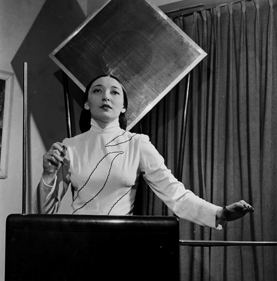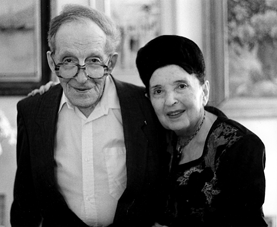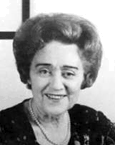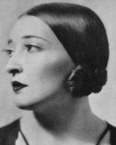Clara Rockmore In Her Own Words
 Uncle Paul, Uncle Pav, my mother’s bachelor brother, the dearest man in the whole world, was responsible (for our musical childhood). He gave the first piano to Nadia, and he was the one who had the patience and the interest to teach me. He wasn’t a musician himself, but he saw some kind of talent, so he taught me to read music, and when I came to the (St. Petersburg) Conservatory, at the age of three, I didn’t yet play the violin. I had absolute pitch, and I played some four-hand pieces with Nadia and a few by myself. There was a newspaper article about it, calling me a “phenomenal child”, and according to the paper, I apparently said that I really didn’t like the piano so much, I preferred the violin. Well, all my Uncle Paul had to know was that I wanted a violin, and he gave me an instrument. And it wasn’t a toy, he bought me a real, little quarter-size violin, which is in my closet to this day (1992), and on which several years later I went so far as to play the Mendelssohn Concerto.
Uncle Paul, Uncle Pav, my mother’s bachelor brother, the dearest man in the whole world, was responsible (for our musical childhood). He gave the first piano to Nadia, and he was the one who had the patience and the interest to teach me. He wasn’t a musician himself, but he saw some kind of talent, so he taught me to read music, and when I came to the (St. Petersburg) Conservatory, at the age of three, I didn’t yet play the violin. I had absolute pitch, and I played some four-hand pieces with Nadia and a few by myself. There was a newspaper article about it, calling me a “phenomenal child”, and according to the paper, I apparently said that I really didn’t like the piano so much, I preferred the violin. Well, all my Uncle Paul had to know was that I wanted a violin, and he gave me an instrument. And it wasn’t a toy, he bought me a real, little quarter-size violin, which is in my closet to this day (1992), and on which several years later I went so far as to play the Mendelssohn Concerto.
When I met the great Professor Leopold Auer, I was exactly four years old. Nobody was allowed to enter the door of his examination room with somebody else present or accompanying them. Well, when the moment came for me, I could only drag my violin in its little original red case behind me on the floor, because I couldn’t lift it. And when the examination committee saw this apparation, they picked me up, put me on top of the (conference room) table. That’s where I had my so-called examination, and that’s where I got the (highest possible) mark of 4+, and became the youngest ever student in the history of the Conservatory.
(Then came) the tragedy. It’s how I finished at the Curtis Institute. I didn’t graduate from Curtis, I just got finished, in more ways than one. Of all Professor Auer’s students, the only one that he chose to play at the graduation concert (the Beethoven Concerto) was me. That was right after my mother died, and I was in great pain, emotionally, and I remember very vividly coming for my first lesson on the Beethoven after her death, and I apologized before I played. I said that I really hadn’t worked the way I usually do, and Auer was very sympathetic. But then I began to work like mad, probably too much, and that undid me. I was never too strong, and, I began to have this unbearable pain in my arm, and when I came and told him I can’t do the concert, it was the one time he was really angry. I remember his voice — he spoke in English — “how could you permit yourself…” And that was the end of me and Auer.
I tried everything. I was ready to have my arm amputated and sewed back if would help. I went from one doctor to another. For six months they immobilized my arm, bound me up so that I had running sores on my skin. I was ready to do anything any doctor suggested. They almost killed me. Every time my arm got a little better, I tried to play again, and immediately the same thing happened. It was almost three years before I knew it was impossible, and even then there followed my pitiful attempts, year after year, to see whether my arm had improved. I could play a bit, but not to my concert level. It was a real tragedy in my life.
When the theremin came along, it was almost like marrying somebody on the rebound, and while it never took the place of the violin, it was something to make music with. Realizing I was a violinist, Theremin offered to change the magnetic poles. “You’re used to producing vibrato with your left hand and the bowings with the right,” he said, “and my instrument is the other way about. I can easily build you an instrument with the poles reversed.” And you know how young and idealistic I was? I remember my answer: “Oh, no. Just because I happened to be a violinist, other people who will follow should play it the way you invented it.” So I learned how to do vibrato with the right hand instead of the left. It was an evolution. As I played more difficult pieces, I always had to invent a way of doing them. A lot of trial and error went into it, but the theremin saved my musical sanity by giving me an outlet in music. It’s very rewarding that I could make something out of the instrument that nobody expected, and maybe wasn’t even meant to be. But I needed to express myself.
As a musician, though, I was not satisfied with the RCA model (of the theremin). I could not tolerate the left hand, which I called “molasses” — there was no way of breaking the sound, so everything had to be played glissando. I needed a faster left hand, to permit staccato, and I wanted low notes as well as high. All I had to do was to inspire Theremin, to explain what I needed, and he, being the genius that he was, built for me a much more exacting instrument. Controlling it was much more difficult, but it was far more responsive, and therefore musically more satisfying. I had to make — and then meet — my own standards; I had to win the public over into thinking of the theremin as a real, artistic medium.”
* * *
The tours with Paul Robeson were wonderful. Paul’s best friend, the one person through his whole lifetime that he most trusted, was my Bobby (Clara’s husband, Robert Rockmore). He trusted him with everything. Now, how did I get into the picture? I can even tell you that — I have complete recollection. I gave a recital in New York where I played the Cesar Franck Sonata with Nadia, which is unheard-of, right? Nadia told me later that Noel Strauss, who was then the #1 (New York Times) critic after (Olin) Downes, came backstage to ask about some encore that I played, and he wrote a fabulous review. So what happened? Bobby, so proud, innocently sent it to Paul Robeson in London, to show off what a wonderful review I had. What is the next thing that happens? Paul’s wife, Essie Robeson, gets an idea. Paul usually would sing three groups, and expected the assisting artist to play in between them. So not Bob, not Paul, but Essie writes back saying wouldn’t it be an interesting kind of thing for me to be that artist. I was young, I was white, I was very nice-looking, and Paul and I were both with Columbia Concerts, and they got excited because I would get the kind of audiences I could never get on my own, while he would have something quite intriguing. That’s how the idea was born, and I did 150 concerts over three years with Paul…
Did Paul encounter problems as a black musician? Let me tell you. We gave a concert at the famous opera house in San Francisco. He sang and I played and the audience eats it up and we have tremendous success, and some of his San Francisco friends take us to a very chic place for supper afterwards. As a woman, dressed in a white gown to the floor, I’m the first one in, with Paul, still in tails, behind me. And the doorman says to me “If you are with that black man, you cannot come in.” The friends were embarrassed, of course, but we all went back to the Fairmont hotel, and they brought up sandwiches to the living room of Paul’s suite. Meanwhile, I went straight to my room, called up Bobby, woke him up in the middle of the night, and told him what happened. And you know, he gets on the phone, and the scandal closed the darn restaurant for two weeks. Paul actually took the whole thing much better than I did…
After that episode, he loved to go with me on a train, You know why? Because he talked only Russian to me. Everybody around us was bursting: who is that big, tall black man, and that little, tiny white woman, talking balderdash. That was his word, “balderdash”. He wouldn’t say one word in English, or permit me to do so; we just talked away in Russian. “Let them all go nuts trying to figure it out,” he said. He had that kind of sarcastic sense of humor, but it comes with pain. Do you know that for years, when Paul came to visit us here (at Clara’s apartment in the Parc Vendome on West 57th Street), we had to tell the doorman to be sure to let him up on the main, not the back service elevator.
Other touring difficulties? We had nothing but problems. Periodically the instrument would go out of order and I would have to call in some electrician who didn’t know anything, or call the old mechanic who worked for Theremin in New York and hope he could advise me what to do. I was forever tearing my hair out in anxiety. The prize event happened somewhere in the south on one of the tours with Paul. The power was out so they had beautiful candelabras to light the hall. I said to the people there, “I’m sorry, I can’t go on, because there’s no electricity.” It was the most difficult thing to convince them. Finally, the governor of the state came to me, saying — I’ll never forget it — “But Madame, you will look beautiful in the candlelight.”
* * *
A lot of experience went into the series of exercises that I wrote, hoping to help future players who wanted to make real music, not sound effects. I dedicated it to my very special friend Robert Moog “in appreciation of his continued interest in promoting and reproducing the space-controlled theremin.” Before you finger the notes, of course, before you do anything, you have to have music in your soul. If I had to give advice to future thereminists, I’d say “less is more.” You cannot treat air with hammers, you have to use delicate motions, you have to play with butterfly wings; precision is much more important than strength. You also have to have courage. Playing the theremin is like being a trapeze artist without a net. You don’t know if you’ll land correctly or not, but you take a risk and you jump, not only to arrive at the right note, but to hit the middle of the note, so you’ll be in tune.
This is not to be preserved as a museum piece. I want people to benefit by it. It’s all free, free, free — no compensation is expected. It’s given with my whole heart.
* * *
LETTER TO THEREMIN, 1/28/75
(translated from the Russian by Margarita Glebov):
The young generation today is very interested in electronics, and even though “our” instrument is one of the very first ones, it is still the most beautiful in terms of sound, and the most magical, because it is the only one that is space- controlled. Now that we are sending people to the moon, I have no doubt that there will be a renewed interest in the instrument from which one extracts the sound with hand motions in the air. Last week, I was invited to do a radio interview, where I answered various questions about the theremin. Of course I spoke about you, your work, and about how the new generation may become acquainted with “space” music. I think that in the near future, it would be very desirable to attract the interest of a fresh young public to your instrument, and I will do everything possible to make it happen.
* * *
A MESSAGE PLAYED AT THE FIRST INTERNATIONAL THEREMIN FESTIVAL
June, 1997
It gives me great joy to be able to address a group sincerely interested in the theremin, the instrument I gave my life to, and to know that I’m speaking to people who continue to love and respect, not only Theremin himself, but the terrific electronic achievement he put into this world.
* * *
ADDENDUM:
LETTERS TO CLARA FROM THEREMIN
(translated by Margarita Glebov)
I am very interested in knowing your opinion and possible advice on the subject of my development of the Theremin’s spatial control, as well as fingerboard control that allows playing the melody accompanied by harmony consisting of seconds, thirds, and more pure intervals. First of all, the pure intervals (rather than tempered) will be taken into account: Major second, minor and Major thirds, fourth, fifth, both sixths, and minor seventh, and octave, altogether 9 intervals. In the spatial two-voice Theremin, unison and these intervals can alternate by the movement of the left hand from left to right.
Soon there will also be an experimental one-voice instrument, which sounds similar to Theremin, but is controlled by the inner nervous biocurrents coming from the body of the motionless performer from the distance of -1 meters. I will describe it in more detail when I come up with a definitive method of playing on it.
12 June, 1965

Clara with Theremin in 1991. Photo: Steve J. Sherman
I am continuing to work on the musical matters and, in particular, on my instrument. The melody on this instrument can be accompanied by a pure one voice or 2- and 3-voice harmony in chords of pure, not tempered tuning, kind of like accompanying sounds located in lower octaves. Controlling the choice of chords with respect to the scale degree may be achieved by moving the left hand right and left, which does not affect the volume. A very good sonority is created for pieces of madrigal and church type and for folk songs.
I very much hope that you will come here soon and I will show you these and other news, such as the change of timbre depending on the pitch of the melody.
The timbre of the instrument may also be manipulated through the whispering of the performer in such a way that the sounds become similar to the singing of those letters that are being whispered, but with a pitch and dynamic level that corresponds to the right hand’s playing of the melody. I am still working on this innovation to make it so it produces a singing effect similar to a good singing artist with good diction.
Right now these apparatuses are still in a research state and are not portable enough for concert performances outside of the acoustic laboratory of the Moscow University, which is where I generally perform these acoustically artistic experiments…
I absolutely can not describe in words how much I miss you and how much I need you.
22 January, 1971
In general, I can tell you that a lot has already been accomplished:
1) The melody, with its just intonation, performed on the Termenvox (this is how the Theremin is called here) may be accompanied by the 2- or 3-voice chords in natural (i.e. pure, not tempered) tuning. Depending on the modal scale degree of the melody, these chords alternate by way of specific, more consonant constructions that I have developed. There are 8 different combinations that produce the highest consonance with the melodic voice. I designate them by triads a, b, c, d, e, f, g, h, and they practically overlap all combinations used by classical composers and in church choirs and folk singing. There are two ways of controlling how it works: one is the spatial control by the left hand by means of moving it left and right, independent of the height of its position which regulates the volume.
Second method is the automatic switch over of the chords in accordance with the scale degree of the melody. Depending upon the character of the melody (major, minor, or other types), the left hand, by moving right and left, turns on the appropriate registers, in the course of a relatively long period of time, for instance, when major transforms into minor, and so on.
These devices allow for a good performance on my instrument, surpassing in clarity and in nuances the usual choir or, for instance, quartet sonority.
2) coordination between the timbre of the instrument and the modal position of the melodic pitch that is being performed. For instance, on the scale degrees that require an accompaniment of a minor third, the harmonics are [removed ?], corresponding to the 5th overtone that has a sound of the major third but two octaves higher.
3) a verbal sonority of the melody that allows romances and songs with words to be performed. Switching on the verbal sonority is accomplished through a weak whisper of a voice, without singing, but in accordance with the rhythm being performed.
Big kisses to you, and I wish you happiness, health and joy.
16 September 1972
There is no progress in my musical world for now. It has not yet been possible to organize a musical studio for one-voice and choir Theremin, Theremintone and my other new instruments, although there have been a number of promises from the managerial personnel. My daughter, the pianist Natasha (33 years old) practices on the multi-voice Theremin and follows as an example your playing on the gramophone record, but she is still far away from your accomplishment. On some of my concert-lectures, I show my playing on the multi-voice instrument and it creates a very good impression on the listeners. We will see — maybe before I die something large-scale will come out of this.
I will wait impatiently for your letter. I send you and your sisters my biggest hello, and wish you health and happiness.
Yours,
Lev S
4 October, 1981


